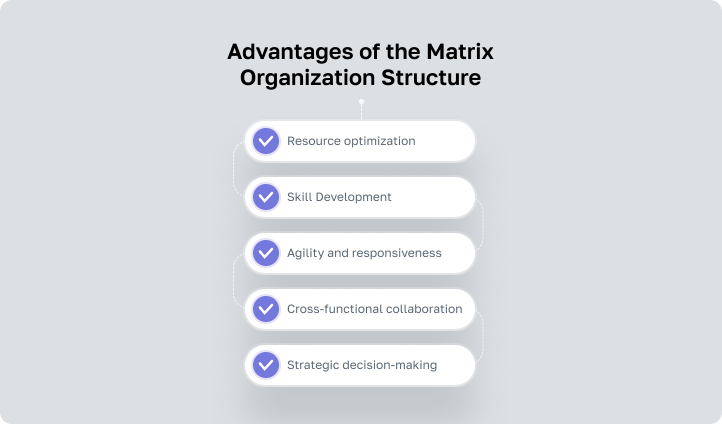Relational Leadership Essentials Fundamentals Explained
Relational Leadership Essentials Fundamentals Explained
Blog Article
The 8-Second Trick For Relational Leadership Essentials
Table of ContentsExamine This Report about Relational Leadership EssentialsThe 5-Second Trick For Relational Leadership EssentialsSome Known Factual Statements About Relational Leadership Essentials Some Ideas on Relational Leadership Essentials You Should KnowRelational Leadership Essentials Fundamentals ExplainedThe Facts About Relational Leadership Essentials Uncovered
Yet, as more firms embrace distributed labor force practices, collective, clear, and flexible frameworks will play an essential role in success - Leadership Essentials. Knowing that a matrix structure's flexibility supports nimble teams, promotes interaction, and values cross-collaboration, it's time to make a decision if your company needs enhancement in these locations. If so, transitioning to a matrix framework may be a strong step in the best instructionsIf your social media advertising and marketing division determines an untapped customer base, your structure needs to make it very easy for the head of that department to communicate this discovery to elderly administration and the sales group. This can be real even if you have a top-down framework in which authority relaxes in the hands of your elderly management group.

The Buzz on Relational Leadership Essentials
No matter the type of business structure you select, there will certainly always be a coverage channel that ends with a last decision maker. As an example, in a flat structure in which staff members are offered large latitude to make recommendations and take ownership of their job procedure, decisions are made based on the agreement of employees functioning in a group.
JOB 1 1. Relational Leadership Essentials.1: Organizations are established to satisfy a requirement, as an example to offer products or services. Organizational structures can take several kinds. These are influenced by elements such as its function, size, and complexity of the tasks it carries out, outside atmosphere and its culture. It's products and services or where its located also determine which structure is best.
Organizations can be structured in various means: by feature, for instance, operations, marketing, financing, fundraising, etc by region by item, as an example, publications, support, consultancy, distribution in job teams, as an example, client/customer teams. On top of the structure is a single individual, that has a little number of people reporting straight to them.
What Does Relational Leadership Essentials Mean?
Benefits of hierarchical frameworks: A hierarchical structure makes use of clear reporting lines. It is very easy to see what each team is called, the amount of individuals there are in each group and exactly how they associate with other individuals in the system. Downsides of hierarchical frameworks: Individuals can feel embeded a 'silo' and miss possibilities for co-operation, both for themselves and the organisation.
There are less levels in the flat framework organisation. In this example structure, there is someone at the top with everyone else reporting into them on an equal level. Benefits of flat frameworks: individuals really feel more engaged and can take on even more responsibility greater interaction better group spirit much less bureaucracy and much easier decision making lowerEven groups of young kids begin to develop a network or casual pecking order.
Relational Leadership Essentials - An Overview

An organizational structure produces a framework for just how a business runs, including the department of responsibilities and authority. Below are the most usual choice org structures in usage: business framework organizational structure business framework organizational structure business framework business structure organizational structure You may ask, what is the ideal business structure?
The person on top has the utmost authority and sets the agenda and method. The supervisors create the strategy and the workers carry out the strategy. Top-down orgs have worked in an organized and easy-to-understand hierarchy for hundreds of years. Every person has a clear line of coverage and understanding of the chain of command.
The Only Guide for Relational Leadership Essentials
Some have actually said that this style of structure is outdated, in a world that is moving so quick. The sight may be good from the top, however what regarding the remainder of your business? Image by mirsad mujanovic/ Licensed under Pexels Certificate Benefits of a top-down org structure consist of: A clear emphasis on instructions and tasks Streamlined decision-making Duties and duties are clear Familiar and comfortable workflow Disadvantages of a top-down org framework include: Staff member have little control or input into the job item Managers might not see spaces in between assumptions and team capacities up until it's far too late Much less independent thinking at reduced degrees Get More Information Low employee engagement and excitement A bottom-up business structure works much in a different way.
Lower-level employees within an organization are granted better authority to address troubles, established instructions, and take on tasks. Instead of technique, ideas, and tasks being handed down from the top, concepts and understandings are created at the base and flow upwards in the bottom-up org structure.
An Unbiased View of Relational Leadership Essentials
While employing the very same concepts as the top-down structures, it further delegates duty and authority to supervisors. Usually used in huge business, duties might be split into divisions or units which managers oversee and establish strategy in their particular areas. Secondary managers produce the implementation strategy and lower-level workers are assigned jobs.
Report this page